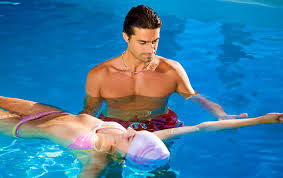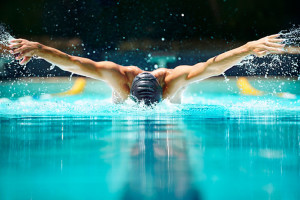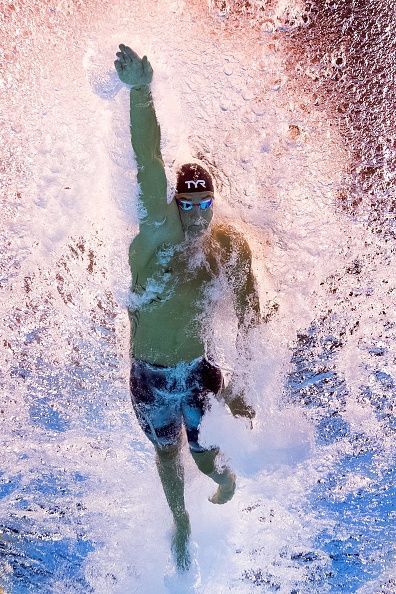 So, you think you can’t swim! I was eight the first time I dove in and swam a full length of the pool. Since then, I’ve swum competitively and non-competitively and racked up more laps than I can count – or remember. While I have never been a fast swimmer, I have always loved the feeling of being immersed. Then sweet feeling I get in the water as my arms and legs work in tandem. Propelling me from one end of the pool to the other.
So, you think you can’t swim! I was eight the first time I dove in and swam a full length of the pool. Since then, I’ve swum competitively and non-competitively and racked up more laps than I can count – or remember. While I have never been a fast swimmer, I have always loved the feeling of being immersed. Then sweet feeling I get in the water as my arms and legs work in tandem. Propelling me from one end of the pool to the other.
Simply put – I love to swim.
When I talk or write about swimming, I tend to get two distinct responses. The first is from other swimmers who smile. They then add their own description of what it feels like to slice through the water. All the while as they accumulate yardage and test their speed. The other response I get is from people who can’t swim wistfully say, “You make swimming sound like so much fun. I wish I could swim, too.”
This article is for those folks who think they Can’t Swim.
Swim Lessons
For those in the U.S., the American Red Cross offers adult swim lessons, to those who can’t swim, in  locations around the country as does U.S. Masters Swimming (USMS offers a list of individual swim instructors as well as pools where adult lessons take place). In Australia, State Swim Swimming Schools offer lessons for all ages, and the Aquatic Center in Sydney offers adult swim lessons.
locations around the country as does U.S. Masters Swimming (USMS offers a list of individual swim instructors as well as pools where adult lessons take place). In Australia, State Swim Swimming Schools offer lessons for all ages, and the Aquatic Center in Sydney offers adult swim lessons.
For many folks who can’t swim, swim lessons that cover the basics are the first places to start. While it may initially feel strange to sign up for lessons. There is no better investment in learning how to properly perform the basic strokes will be worth it. It will make lap swimming much more enjoyable, and lower the risk of swim-related injuries.
DIY Swim Programs
For those who may have a little background in swimming or those who aren’t keen on signing up for lessons, there are other options. One of the most touted programs is renowned NCAA coach Terry Laughlin’s Total Immersion Swimming Technique. The program is based on the premise that there is more benefit to approaching swimming as a skill, rather than as a test of endurance.
 Laughlin’s program focuses on the three C’s (comfort, control and confidence), taking the path of least resistance (streamlining form and not making waves), and moving from the core (better integration of strokes and core support). One of the most compelling testaments to Laughlin’s method can be found in Tim Ferris’s blog article detailing how he learned to swim in ten days using the Total Immersion method.
Laughlin’s program focuses on the three C’s (comfort, control and confidence), taking the path of least resistance (streamlining form and not making waves), and moving from the core (better integration of strokes and core support). One of the most compelling testaments to Laughlin’s method can be found in Tim Ferris’s blog article detailing how he learned to swim in ten days using the Total Immersion method.
Swim Clubs and Clinics
If you’re someone who has a little more experience swimming but just doesn’t know where to start in terms of training, there are many local clubs that welcome swimmers of all abilities. The benefits of joining a swim club are that you’ll get coaching support and regular workouts designed by someone who understands the need for adapting workouts to different levels. You’ll also be swimming with swimmers of varying levels, and who will often offer advice regarding stroke and breathing techniques. Swim clubs can also provide additional motivation for those who want to get into the pool but have trouble making time for the workouts.
For those looking to improve their skills, but not able to invest the time in lessons, U.S. Masters Swimming offers regular stroke clinics around the country. Designed for every level of swimmer, the stroke clinics offer an evaluation of all four strokes (though swimmers aren’t required to swim all four strokes) by top area coaches. The goal of the clinic is to help swimmers improve stroke technique and to teach them drills that will enable them to continue to refine their strokes as they swim.
No matter what level swimmer you are, there is a program that can help you. You too can find a way to enjoy swimming. Plus reap the benefits of what many consider to be the perfect exercise!
